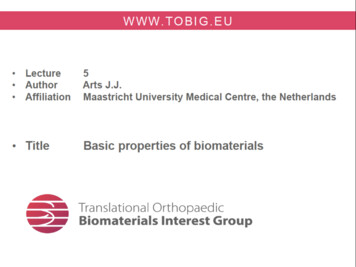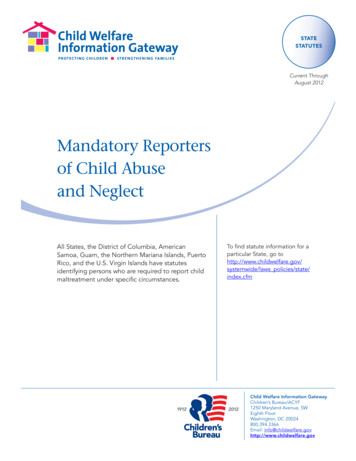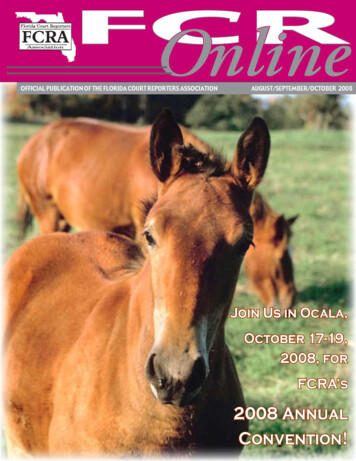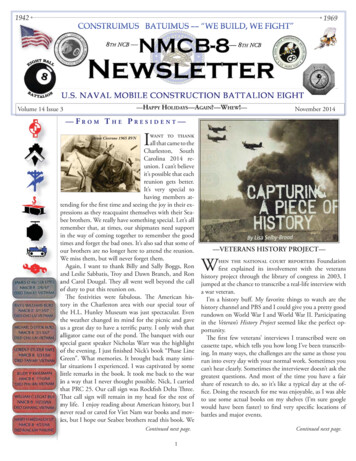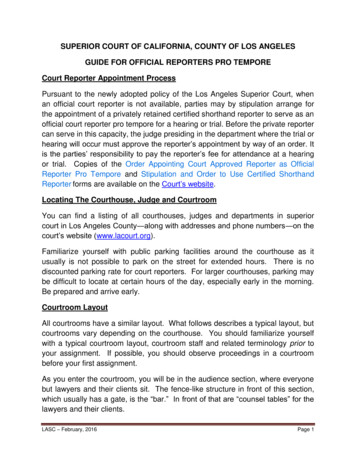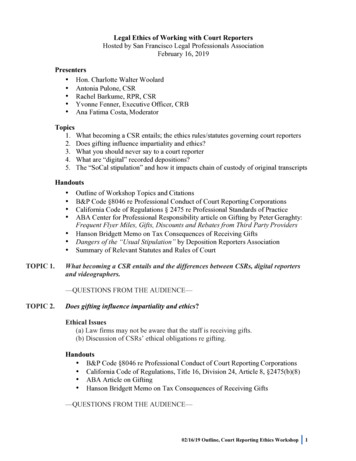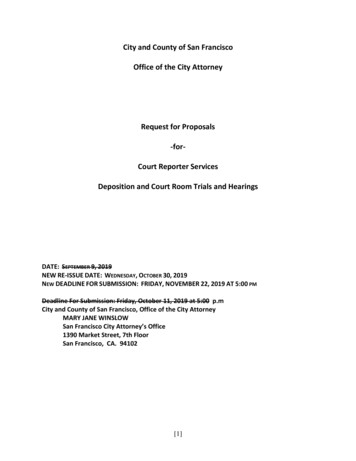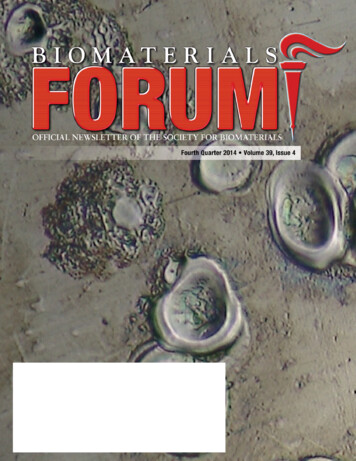
Transcription
Biomaterials Forum, the official news magazineof the Society For Biomaterials, is publishedquarterly to serve the biomaterials community.Society members receive Biomaterials Forumas a benefit of membership. Non-membersmay subscribe to the magazine at the annualrate of 48. For subscription informationor membership inquiries, contact theMembership Department at the Society office(e-mail: info@biomaterials.org) or visit theSociety’s Website, www.biomaterials.org.It is the policy of the Society For Biomaterialsthat all articles reflect only the views ofthe authors. Publication of articles oradvertisements within Biomaterials Forum doesnot constitute endorsement by the Society or itsagents of products, services or views expressedherein. No representation is made to theaccuracy hereof, and the publication is printedsubject to errors and omissions. Articles that donot have an author byline may originate frompress releases. The Society For Biomaterialsretains press releases on file for a period of oneyear from the date of publication.The official news magazine of the SOCIETY FOR BIOMATERIALS Volume 39, Issue 4Executive EditorLiisa T. Kuhn, University of Connecticut Health Center,Reconstructive Sciences, Biomaterials and Skeletal Development236 Farmington Ave. MC1615, Farmington, CT 06030-1615Phone: (860) 679-3922 Fax: (860) 679-1370E-mail: lkuhn@uchc.eduManaging EditorSarah Black, Society For Biomaterials1120 Route 73, Suite 200, Mt. Laurel, NJ 08054Phone: (856) 380-6905 Fax: (856) 439-0525E-mail: sblack@ahint.comGovernment NewsContributing EditorCarl G. Simon Jr, NISTBiosystems & Biomaterials DivisionE-mail: carl.simon@nist.govIndustrial NewsContributing EditorSteve T. Lin, Exactech Inc.E-mail: steve.lin@exac.comSociety Business & MembershipNews Contributing EditorEditorial contributions to BiomaterialsForum are always welcome. Contributionsshould be sent to the Executive Editor andare subject to the terms and conditions of theEditorial and Publication Release. Authorsshould refer to the Author Guidelines, whichare available on the Society’s website, whenwriting submissions. The publisher accepts noresponsibility for return or safety of artwork,photographs or manuscripts. Submissionof editorial content does not guaranteeacceptance or publication.Education News Contributing EditorAddress corrections should be sent toBiomaterials Forum, 1120 Route 73, Suite 200,Mt. Laurel, NJ 08054.Historical Flashback EditorRequests for advertising information should bedirected to Sarah Black at sblack@ahint.com or(856) 439-0500, ext. 4240. Information is alsoavailable on the Society’s website,www.biomaterials.org.Unauthorized reproduction of this magazinein whole or in part is prohibited without thepermission of the publisher. Requests forpermission should be directed to theManaging Editor.Scientific photos may be submitted for coverconsideration in future issues. Submit colorphoto, no larger than 4” x 6”, along with creditinformation and scientific description, to theExecutive Editor.Copyright 2014 ISSN 1527-6031Society For BiomaterialsAll rights reservedSpecial Interest Group NewsContributing EditorHorst von Recum, Case Western Reserve UniversityDepartment of Biomedical EngineeringE-mail: horst.vonrecum@case.eduSteve Little, University of PittsburghDepartment of Chemical EngineeringE-mail: slittle@engr.pitt.eduBook Review EditorLynne Jones, Johns Hopkins UniversityDepartment of Orthopaedic SurgeryE-mail: ljones3@jhmi.eduAIMBE News Contributing EditorLynne Jones, Johns Hopkins UniversityDepartment of Orthopaedic SurgeryE-mail: ljones3@jhmi.eduStudent News Contributing EditorYusef Khan, University of ConnecticutDepartment of Chemical, Materials andBiomolecular EngineeringE-mail: ykhan@uchc.eduGuigen Zhang, Clemson UniversityDepartment of BioengineeringE-mail: guigen@clemson.eduJordan GilmoreE-mail: jagilmo@clemson.eduSpecial Interest Group ReportersBiomaterials & Medical Products CommercializationBiomaterials EducationBiomaterial-Tissue InteractionCardiovascular BiomaterialsDental/Craniofacial BiomaterialsDrug DeliveryEngineering Cells & Their MicroenvironmentsImmune EngineeringNanomaterialsOphthalmic BiomaterialOrthopaedic BiomaterialProtein & Cells at InterfacesSurface Characterization & ModificationsTissue EngineeringNihar Shah nihar.shah@uky.eduGreg Hudalla ghudalla@bme.ufl.eduFloyd Karp floyd@u.washington.eduNatalie Artzi nartzi@mit.eduSachin Mamidwar smamidwar@orthogencorp.comScott Guelcher scott.guelcher@vanderbilt.eduAdam Feinberg feinberg@andrew.cmu.eduJulie Stenken jstenken@uark.eduSteven Eppell sje@case.eduMorgan Fedorchak mod8@pitt.eduJessica Amber Jennings jjennings@memphis.eduSumona Sarkar Sumona.sarkar@nist.govNihar Shah, PhD nihar.shah@uky.eduAbby Whittington awhit@mse.vt.edu
ContentsThe TorchOn the cover: Digital optical micrograph of inflammatory cell induced2From the Editorcorrosion attack of a CoCrMo metal-on-metal total hip replacement3From the Presidentacetabular component. Inflammatory cells (from the phagocytic8Staff Updatemononuclear cell line, e.g., osteoclasts, neutrophils, macrophages,News & Updates5HistoryThe Foundation for Society For Biomaterials6 Opinion The Tenth Question10 Member News12 Historical Flashback Selective Luck Led One to Become aPioneer in the Field of Biomaterialsand foreign body giant cells) have been demonstrated to attach to anddirectly corrode CoCrMo alloy implant surfaces in-vivo. These cellsall generate oxidative burst-like reactions generating reactive oxygenspecies, and utilize Fenton reactions that can directly corrode CoCrMoalloys in vivo. Scale bar 50 μm. Photo courtesy of Professor JeremyGilbert, Syracuse University.13 New Approaches in Biomaterials Two Novel Calcium Phosphate PrecipitationTechniques14 Antioxidant Biomaterials Promote HealingBy Combating Oxidative Damage16 SIG NewsBiofunctional Relevance of SyntheticMucin Mimics Formed by Affinity-DrivenFilamentous Nanostructures19 News from the Surface Characterization &Modification SIG20 N ews From The Biomaterials & MedicalProduct Commercialization (BMPC) SIG21 Student Chapter Update Professional Development Opportunitiesfor Students22 Government News22 New Journal of Interest23 Industrial News25 Education News STEM Education and the Numbers Behindthe Hype27 Book Review: No Time to Die29 Coming Up in 2015BIOMATERIALS FORUM Fo u r th Quarter 20141
From the EditorGREETINGS FELLOWBIOMATERIALS SCIENTISTS,As I compiled the content fromthe various editors for this issue ofthe Society For Biomaterials (SFB)Forum, I realized once again what aspecial group of members we havein the SFB and how fascinating theworld of biomaterials is. Our members have a great depth ofknowledge that they are applying to solve the health problemsof the world; most importantly they are willing to take thetime to share that knowledge through this publication andothers. While our annual meeting only occurs once a year,you can keep up to speed on the latest in biomaterials byreading the Forum or by browsing the SFB website. TheForum is a great way to find out what your colleagues havebeen doing and to discover how various areas of biomaterialsresearch are progressing from a multipronged perspective:academic, industrial, clinical, and governmental. Th e Government News article in this issue features anannouncement about a Cell Manufacturing Consortiumthat is being planned by the Georgia Research Allianceand funded by the National Institute of Standards andTechnology to help establish the United States as theleader in cell manufacturing technology. The goal of theconsortium, with nine founding partners from acrossthe country, is to “establish a collaborative public-privatepartnership that engages industry, academia, regulators, andother stakeholders in removing barriers to the advancementof the cell-manufacturing industry, thereby bringing newtherapies and diagnostics to the healthcare market.” Th e Surface Characterization & Modification (SC&M)Special Interest Group (SIG) contributed a short technicalarticle and two other SFB members share their recentcontributions to the field of biomaterials in short technicalarticles as well. General updates from both the Biomaterials& Medical Product Commercialization SIG and the SC&MSIG are found in this issue. Getting involved with a SIG isa great way to establish contacts with colleagues who sharethe same subspecialty interests, and as a means to influencescientific programming at the annual meeting. Th is issue’s Historical Flashback column contains areflection from Dr. Jonathan Black, SFB founding member2BIOMATERIALS FORUM Fo u r t h Q u ar t er 2 0 1 4The Torchand Past President, about what we’ve learned, or haven’tlearned, over the past 20 years from studying the clinicaloutcomes of orthopaedic devices such as total hips or knees. B e sure to read Industrial News for an overview ofthe latest product releases, mergers and acquisitions,regulatory issues, job outlooks, and other notable corporateachievements or concerns. It may provide some direction orguidance for your next endeavor. S tudent Chapter President, Jordon Gilmore presents anadvice-packed Student News column aimed at graduatingstudents. His message is that there’s no time like the presentfor professional development. O ur SFB members continue to receive prestigiousprofessional awards and advancements, and move on toother new opportunities. Read Member News to learn moreand be inspired by what your colleagues have achieved. I recently read a fun book on a long airplane flight thatmade the time speed by. Most of the main characters inthe book are research scientists and entrepreneurs! Andyet the book is a thriller/murder mystery. Hard to imaginethat combination, but that’s the case in “No Time to Die.”See the Book Review on the last few pages of this issue tolearn more.Please help us to make sure this publication continues toreflect news of interest about the diverse and fascinating fieldof biomaterials by contributing a short technical article oropinion piece. Send your draft articles or any questions aboutcontent to me at Lkuhn@uchc.edu.See you soon in April at the annual meeting!Best wishes,LIISA KUHN, PhDBiomaterials Forum Executive EditorAssociate ProfessorUniversity of Connecticut Health Center
From the PresidentFor as long as I can remember,the students in the Society ForBiomaterials (SFB) have had aconsiderable role in helping ourSociety evolve into an internationallyrenowned organization. Whileattending the meetings in the late1980s and 90s, it was evident to methat students and fellows gave many, if not most, of thepresentations in the plenary sessions. This is still truetoday at our annual meetings. As the years have passed,students have become more involved in various aspectsof the Society, including development of The NationalStudent Section of SFB, involvement in the SpecialInterest Groups (SIGs), and social interactions at theannual meeting. However, the Society can do more forour students. Years ago, when I was attending one of theannual business meetings of the Society, Professor BobBaier from the University of Buffalo remarked that “Weneed to engage our students, as they are the life and bloodof this organization.” I recall those words from Dr. Baier,not only at that business meeting, but at others, becausethis is still an important issue today. In this letter, I wouldlike to update you on some initiatives the Society has beenworking on over the past year to promote more studentinvolvement and engagement. I also suggest some ideas forthe future of our Society based on engaging our students,as well as what is perhaps a forgotten group, our fellowsand postdoctoral fellows.An important concern is attracting students to ourSociety during their tenure, not only as students, but alsowhen they transition to an academic, governmental, orindustrial positions. Students have organized a numberof student chapters and this number has appreciably risenin the last five years, perhaps due to the many initiativesput forth, such as Biomaterials Days or the BiomaterialsEducation Challenge. We currently have 29 studentchapters in the United States with 478 student membersin these chapters. Local student chapters must compriseat least three student SFB members to remain active. Ourmost recent data indicates that 10 of the 29 local studentchapters have less than the required three student SFBmembers and eight chapters have only three student SFBmembers. These numbers are surprisingly low and may bedue to local chapter laws, but I believe we can increase thenumber of student SFB members. One way of doing this isThe Torchthrough an initiative being discussed by the MembershipCommittee, chaired by Dr. Kurt Kasper, to implementa plan offering a discount on each current student’s SFBmembership fee, as well as incentivizing our studentchapters to increase membership. This is a sound approach,as it presents minimal fiscal risk, provides reduced fees tojoin an organization for students, strengthens our studentchapters, and brings more money and more members toour Society. In the short term, our membership increases,but I would hope that as students transition in theircareers, they remember how our Society provided supportduring their lean early years. This offer of some financialsupport, albeit small, asserts that our Society is supportiveand appreciative to students, and we would hope thatthey would consider full-time membership as they entertheir new (and hopefully more lucrative) careers. Thisplan seems to be a win-win situation, benefitting both ourstudents and our Society.“We need to engage our students,as they are the life and blood ofthis organization.”—Bob BaierProfessor from the University of Buffalo,annual business meeting of SFBOur Biomaterials Days have been a success sinceDr. Lynne Jones introduced this program during herservice as President of the Society. The BiomaterialsDays, more often than not, are co-sponsored by multipleinstitutions, with the student chapters directing theentire program. Most of the programs have an industrycomponent, such as an industry panel discussion; somehave had appreciable industry financial support. TheSociety currently supports six different Biomaterials Days;the plan for 2015 and beyond is to expand this programto seven or more sites. There are some concerns that willneed to be addressed in the coming years, including fiscalsupport and what institutions will receive that support. WeBIOMATERIALS FORUM Fo u r th Quarter 20143
The TorchFrom the President (continued)should strongly encourage our student chapters who havenot had a Biomaterials Day to contact other institutionsand industries in their region and consider hosting one.This is an excellent experience for the student membersand is an opportunity to bring our community of scientistsfrom academia and industry together in a particularregion. If we can increase our student membership andthen increase the number of student chapters, we can beginto think about having more Biomaterials Days. It is alsotime to review the impact of Biomaterials Days; this will bebrought to the Long Range Planning Committee chairedby Dr. Thomas Webster, our President-Elect.The Education and Professional Development Committee,chaired by Dr. Tim Topoleski, has been meeting this yearand discussing a plan to improve mentoring within ourSociety. Our Society has already done some mentoringby hosting the student/academia/government/industryluncheons at our annual meeting. This format givesstudents a chance to meet with academic, government,and industry members. Having participated in thisevent, I believe this has been a huge success and shouldcontinue. However, we can do more to help mentor ourundergraduate and graduate students, as well as what Icall a forgotten group, our postdocs, fellows, and juniorassociates. These groups of former students would benefitfrom some further mentoring in such areas as manuscriptand grant preparation, journal and grant reviewing,“ We can only grow and sustainregulatory issues, and mentoring on transitioning to a newposition, whether in academia, industry, or government.About three years ago, during Dr. Joel Bumgardner’sPresidency, the Biomaterial Education Challenge wasinitiated and has been very successful. This program hasgenerated a number of various interesting projects that havebeen presented at our annual meetings. The projects weretargeted mostly to middle school or high school studentsto promote biomedical engineering principles and/orexposure to biomaterials research. Again, the Educationand Professional Development Committee is working onhow to organize this information so it can be promoted onour website, as well as distributed and/or marketed to K-12schools throughout the country. This is a very good idea, asit promotes an interest in science to our youth, and gives ourSociety positive publicity in local communities.Professor Baier’s comment about our students being the lifeand blood of our organization still rings true. I think abouthow good a society or organization is and would contendthat, as a student, I would remember an organization thatstrongly supported me. I encourage our academic membersto emphasize to their students and postdoctoral fellowsthat membership in our Society is valuable. I stronglyencourage our members in industry and government toindicate to their junior associates the same. We can onlygrow and sustain our robust organization by having anengaged membership and I encourage you to offer any ideas,suggestions or comments as to how this can be done, nowand in the future of the Society For Biomaterials. Pleasecontact me at npz@case.edu.our robust organization byhaving an engaged membership”—Nicholas P. Ziats, PhDCase Western Reserve UniversityPresident, Society for Biomaterials4BIOMATERIALS FORUM Fo u r t h Q u ar t er 2 0 1 4NICHOLAS P. ZIATS, PhDCase Western Reserve UniversityPresident, Society For Biomaterials
The Foundation forSociety For Biomaterials (SFB)In 1969, a number of researchers in the biomaterials fieldinitiated a series of International Biomaterials Symposia,concentrating predominantly on materials for reconstructivesurgery. As these symposia became increasingly popular,the idea to establish a dedicated biomaterials organizationgerminated. The Society For Biomaterials (SFB) wasformally established in April 1974.The purpose for the formation of SFB was, and remains today: To encourage, foster, promote, and advance research,development, and education in biomaterials sciences To promote, initiate, support, and accomplish cooperativeresearch, development, and educational programs in this field inthe public interestThe initial Board of Directors was composed of Dr. C.William Hall, Dr. Samuel F. Hulbert, Dr. Sumner N. Levine,Dr. Sigmund A. Wesolowski, and Dr. Richard S. Woodbury,and the inaugural annual meeting of SFB was held April 26,1975, at Clemson University in Clemson, South Carolina.The Society recognized its founder Dr. C. William Hall withboth an annual award and a scholarship in his name.HistoryBy 1980, the First International Congress of Biomaterialswas held in Vienna, Austria.SFB is the oldest scientific organization in the field ofbiomaterials and has enjoyed tremendous growth andsuccess over the years. In order to stay on the cutting-edgeof the ever-changing, fast-paced field of biomaterials, SFBsupports 14 Special Interest Groups (SIGs), whose purposeis to provide a forum for networking and new ideas within afocused environment. SFB also cultivates student chapters atmany universities.The Society continues to be the world leader in the fieldof biomaterials by organizing an annual meeting in theUnited States and by participating in the quadrennial WorldBiomaterials Congress. These meetings are designed forindustry, academia, and clinicians to gather and discuss thelatest trends and scientific breakthroughs pertinent to thefield of biomaterials.Since its founding in 1974, the Society has been “giving lifeto a world of materials.”For more visit biomaterials.org.Presidents of participatingsocieties included [standingfrom the left] Jean Leray(France), Larry Hench (U.S.),David Williams (U.K.), FrankCooke (U.S.), Adam Wesolov(U.S.), unknown, ThomasSalthouse (unknown), LarryKatz (unknown), [seatedfrom left] unknown, GeorgeWinters, C. William Hall andSamuel Hulbert.BIOMATERIALS FORUM Fo u r th Quarter 20145
The Tenth QuestionJ O N AT H A N B L A C K , P H D, F B S E , C H A RT E R S F B M E M B E R A N D PA S T P R E S I D E N T, A N D P R O F E S S O R E M E R I T U S O FBIOENGINEERING, CLEMSON UNIVERSITYSOME REFLECTIONS ON THE 2005 BANANA CORP. (BA) – INVENTORCONSULTANTS’ MEETING †As I sat in the meeting sessions thatlast month of 2005,* I reflected on thepast. The past year saw two importantmilestones for a dear friend of mine,Mr. Robin Ling. December 2005 wasmarked by the 35th anniversary ofhis first surgical procedure with whatbecame known as the Exeter Hip, as wellas the sale of the 500,000th Exeter femoral stem. I thoughtabout my long acquaintance with him, of spending time inExeter, U.K., in 1978, and of our many subsequent encounters.Here are some questions I had about total hipreplacement and BA in 1995:[1] What were the demographics of U.S. patients who receivedBA products that year? How many were there and howwere they distributed by gender, height, weight, diagnosis,and health status?[2] What were their hopes and aspirations before theprocedure? And how well were these met in the short,intermediate, and long term?[3] What BA devices were sold in the United States (and howmany of each variation)?More recently, as I mulled over what I had heard and notheard at that meeting years ago, some questions came tomind. I had read the Second Annual Report of the NationalJoint Registry for England and Wales1 and been remindedthat the U.K. National Institute for Clinical Excellence(NICE) had established measurement benchmarks forevaluation of total hip replacement outcomes at 3 and 10years post-operative. Thus my thoughts turned back to 1995.[4] How did surgeons decide which BA device was appropriatefor each patient? And what would they have liked (but didnot have) for primaries? For revisions?[5] What surgical procedures, anesthesia regimens,rehabilitation programs, and pre- and post-operative paincontrol measures were in use?In 1995:[6] How many patients had subsequent procedures onthe replaced joint or others, or have died (and forwhat reasons)? Newt Gingrich was Speaker of the House and Bob Dole wasSenate Majority Leader.[7] How many BA devices remain in use and what happenedto the rest? Bill Clinton was the 42nd President, nearing the end of hisfirst term.[8] For BA devices that were removed, what was theircondition and how was it related to their removal? The Murrah Federal Building in Oklahoma City was bombed,with 168 people killed.[9] What are the interrelationships between the answers tothese questions? How do these compare to the experiencefor devices manufactured by others and for those that BAsold outside the United States that year? O.J. Simpson was acquitted of the charge of murdering hisformer wife, Nicole Simpson, and her friend, Ron Goldman. The Federal highway speed limit of 55 mph was repealed. The national unemployment rate averaged 5.6 percent.On reflection, in 2005, I failed to hear answers to any ofthese (and other related) questions.Which brings me to thetenth question: The San Francisco 49ers beat the San Diego Chargers49-26 in Super Bowl XXIX and the Atlanta Braves took theWorld Series 4-2 over Cleveland.[10] In 2015, 10 years on, what will we know about the “class”of 2005?†6BIOMATERIALS FORUM Fo u r t h Q u ar t er 2 0 1 4 anana Corp. (BA) is a fictitous device manufacturer name inserted to keepBthe identity of the manufacturer in question anonymous.
OpinionThe Spanish philosopher Jorge Santayana remarked, “Thosewho cannot remember the past are condemned to repeat it.”2What would he say about those who do not know their ownhistory and thus cannot be expected to learn from it? And,for that matter, what about total knee replacement?I had emphasized three themes in my advice toBA in 2005: In the short term, simplify surgery such that averagesurgeons can be consistently good enough. In the intermediate term, recognize that implant andinstrument technology are already good enough and focuson human factors, concerning both patients and surgeons,to seek improved outcomes and satisfaction. In the long term, understand that the emerging revolution inbiomedicine, especially regenerative medicine, will radicallyalter the approach to joint disease and disability.PostscriptIt is clear that these comments, written in the context of theconduct of a single U.S. orthopaedic implant manufacturer,apply equally well to all of their competitors and, in fact,to nearly all U.S. manufacturers of surgical implants andother durable medical devices. The adverse public healthand financial consequences of this lack of “vital statistics”concerning medical devices, on which so many Americansdepend, were obvious in 2005 and remain so today.* December, 2005. These reflections were written in January 2006; slightlyrevised for publication October 2014.REFERENCES1. National Joint Registry for England and Wales, 2nd Annual ls/0/documents/england/reports/njr ar 2.pdf.Published September 2005.2. Santayana, George (Jorge). The Life of Reason, Vol. 1. C Scribner’s sons; 1905-6.While these views still seem appropriate, I remain concernedthat lack of knowledge of the past and present clinicalexperience with Banana’s and competitor’s productswill become an increasingly insurmountable barrier toevolutionary, let alone revolutionary (disruptive), change andimprovement. If BA and others continue to conduct theirbusiness as previously conducted, I fear that the answer to thetenth question will be, “No more than about the class of 1995.”BIOMATERIALS FORUM Fo u r th Quarter 20147
Staff UpdateB Y DA N L E M Y R ED an Lem y re, SFBEx ecuti v e Di rectorHello from Society For Biomaterials(SFB) headquarters! I am writing theStaff Update for the first time in severalyears because of a change in personnel.Leslie Clark has gone on to serve theAmerican Society for Transplantationas their Executive Director. We wishher every success in her new position,and thank her for her service to SFB.It is my distinct pleasure to announcethat we have hired a new AssistantExecutive Director who is alreadygetting up to speed. Please join me inwelcoming Deb Dupnik to the SFBheadquarters staff.Deb holds a B.S. in Microbiology fromthe University of New Hampshire andwas ASCP certified. She is married withtwo daughters (her oldest is an architectand the youngest just graduated with a degree in BiomedicalEngineering). Deb has been with Association Headquartersfor 5 years serving a few different clients during her tenurehere, but has reported that with her new role at SFB, she hasfinally found a home that engages her passion for science.Deb Dupni k, SFBAssi s tant Ex ecuti v eDi rectorIn other news, preparations for 2015 and beyond are wellunderway. The Annual Meeting, budget preparation, andgreat new possibilities for collaboration in 2016 are allissues that will have been discussed by the Society Boardof Directors and Governing Council at their Nov. 6, 2014meeting. The Society’s Board of Directors, governingcouncil, committees, task forces, and Special Interest Groups(SIGs) will be working to advance the Society’s mission asdescribed here.AWARDS, CEREMONIES AND NOMINATIONSCH A I R J A M E S M. AN D ERS O N , MD , P hDThe Awards, Ceremonies and Nominations Committee hasreceived 34 award nominations and 11 nominations for thethree open officer positions. Pending Council’s ratification tothe proposed slate, award winners and officer candidates willhave been announced in November. Thank you to all thosewho made nominations, and please start thinking aboutpossible nominations for next year!BYLAWSCH A I R A N N SAL AMON E, P hDThe Bylaws Committee is discussing some suggestions madeto changes in the Society’s governance structure, includingthe length of the President’s term, the possible addition of a8BIOMATERIALS FORUM Fo u r t h Q u ar t er 2 0 1 4second member at large, and changes to the composition ofthe Finance Committee. Their recommendations will also bereviewed by the Council before they solicit support for anyproposed changes.DEVICES AND MATERIALS COMMITTEECHAIR SHROJAL DE SAI, Ph DThe committee is actively supporting the second SFBBusiness Plan Competition, which was developed by theBiomaterials & Medical Products Commercialization SIG,and is working to organize a third workshop in collaborationwith the Chinese Society For Biomaterials (CSB), inconjunction with the CSB 2015 meeting in Haikou, China.EDUCATION & PROFESSIONAL DEVELOPMENTCHAIR T IM T OPOLE SKI, Ph DThe E&PD Committee is soliciting applications for the2015 C. William Hall Scholarship. They are currentlyevaluating grant applications for the 2015 Biomaterials Dayprogram. In addition, the committee is developing severalnew initiatives, including a series of webinars, programs inmentorship, K-12 outreach, and a course content/curriculasharing portal on the SFB website.Undergraduate students interested in attending the SFBAnnual Meeting should apply for the C. William Hallscholarship. This award honors the memory of the Society’sfirst president, Dr. C. William Hall. The recipient of thethis scholarship will have all of his or her expenses paid forparticipation in the SFB 2015 Annual Meeting, includingairfare, hotel, transfers, registration, and meals. (Somelimitations apply.)FINANCECHAIR LISA FRIIS, Ph DDevelopment of the 2015 budget is underway. In 2014,SFB invested in a new website, and provided the inclusi
Liisa T. Kuhn, University of Connecticut Health Center, Reconstructive Sciences, Biomaterials and Skeletal Development 236 Farmington Ave. MC1615, Farmington, CT 06030-1615 Phone: (860) 679-3922 Fax: (860) 679-1370 E-mail: lkuhn@uchc.edu Sarah Black, Society For Biomaterials 1120 Route 73, Suite 200, Mt. Laurel, NJ 08054
